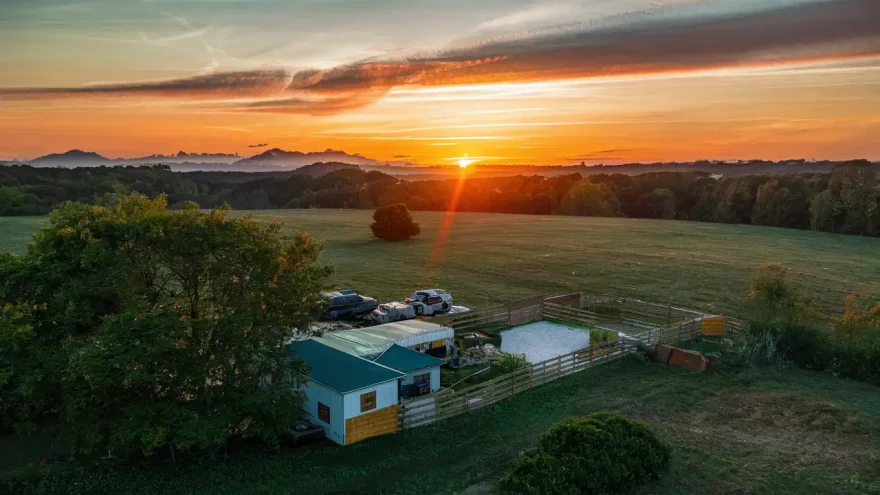Homesteading has seen a resurgence in popularity as people seek self-sufficiency, sustainability, and a return to simpler ways of living.
If you’re passionate about this topic and want to share your journey, tips, and insights, starting a homesteading niche blog can be a rewarding venture.
As people seek alternatives to modern urban life, the homesteading niche for blogging offers a rich source of content and potential for both passion-driven writing and profitable endeavors.
What is a homesteading niche?
Homesteading revolves around living a self-sufficient lifestyle, including growing your own food, raising livestock, preserving food, and making your own clothes and household items.
It’s a lifestyle that appeals to those looking to reduce their carbon footprint, save money, and live a more meaningful and hands-on life.
Capturing this essence in a blog allows you to share your experiences, offer tips to like-minded individuals, and even monetize your knowledge and skills.
A homesteading niche would then refer to a specialized focus or area within the broader concept of homesteading.
Finding your homesteading niche
Finding a niche in homesteading can involve concentrating on a particular type of product, skill, or aspect of self-sufficient living that distinguishes your homestead from others.
For instance, some may focus on organic gardening, sustainable energy use, or a specific type of livestock.
Homesteaders might also carve out a niche by applying unique skills or fulfilling a specific demand in the marketplace, such as offering artisanal cheeses or specialized woodworking products.
Why is the homesteading niche so appealing?
- Growing audience: Interest in gardening, raising livestock, food preservation, and other homesteading skills has surged in recent years. People are concerned about food security, sustainability, and escaping the hustle and bustle.
- Vast sub-niches: Homesteading encompasses a wide range of topics:
- Gardening
- Animal husbandry
- DIY projects
- Traditional skills
- Off-grid living, and more.
- Passionate community: Homesteaders are often enthusiastic and eager to share their knowledge and experiences, creating a strong sense of community for bloggers to embrace.
- Multiple income streams: The homesteading niche supports various monetization avenues, including affiliate marketing, product sales, services, and sponsored content.
History of homesteading
Homesteading has its origins in the pioneering days when governments encouraged settlement of new lands by offering parcels of land to those willing to work and live on them.
In the United States, for instance, the Homestead Act of 1862 allowed many Americans to claim and settle land for agricultural development.
This historic movement laid the groundwork for what homesteading would become: a way of life centered around independent living off the land.
Homesteading niches for blogging

Here are several homesteading niche ideas that can help you carve out a unique space in the blogging world:
1) Urban homesteading
Urban homesteading brings the principles of self-sufficiency to the city.
Topics can include container gardening, small space composting, indoor herb growing, and raising chickens in a backyard.
Share how to maximize limited space to grow food, recycle waste, and live sustainably in an urban environment.
Example blog (s):
2) DIY projects and crafts
Focusing on DIY projects and crafts can attract readers interested in making their own household items.
From building chicken coops and greenhouse setups to creating homemade soaps and candles, tutorials that provide step-by-step instructions and photos can engage your audience and encourage them to start their projects.
Example blog (s):
3) Organic gardening
Organic gardening is a cornerstone of homesteading.
Use your blog to offer guidance on starting an organic garden, composting, natural pest control, and heirloom seed preservation.
Detailed guides on growing specific fruits, vegetables, and herbs organically can also be very popular.
Example blog (s):
4) Sustainable living
Sustainable living covers a broad range of topics aimed at reducing one’s environmental footprint.
Write about renewable energy sources for homesteads, water conservation techniques, and sustainable building materials.
Sharing personal experiences with sustainable practices can inspire readers to adopt eco-friendly habits.
Example blog (s):
5) Homestead cooking and preserving
Homestead cooking and preserving food for the winter months are vital skills.
Share recipes that use home-grown produce, tutorials on canning, drying, and fermenting foods, and tips for meal planning with seasonal ingredients.
You could also delve into traditional cooking methods, such as using a wood stove or baking bread from scratch.
Example blog (s):
6) Homestead animal care
Raising animals is a significant aspect of many homesteads.
Blogs can focus on the care and feeding of chickens, goats, bees, and other farm animals.
Provide advice on ethical animal husbandry, homemade animal feed recipes, and how to use animals for natural pest control and fertilization.
7) Financial independence through homesteading
Many homesteaders aim for financial independence by living off their land.
Discuss how to monetize a homestead through selling produce, homemade goods, and offering workshops or tours.
Tips on budgeting, frugal living, and diversifying income streams can also be included.
Example blog (s):
8) Homesteading for families
Families embarking on the homesteading journey face unique challenges and joys.
Share insights on homeschooling, involving children in homesteading activities, and balancing work with homestead life.
Stories from your family’s experiences can offer valuable lessons and inspiration.
Example blog (s):
9) Herbalism and natural remedies
Focusing on herbalism and natural remedies, this niche covers growing medicinal herbs, making herbal remedies, and using herbs in daily life for health and wellness.
Educational content on identifying herbs, their benefits, and how to safely use them can be both informative and engaging.
Example blog (s):
10) Homestead planning and development
Starting a homestead from scratch requires careful planning and development.
Offer guidance on selecting land, designing a homestead layout, and planning for water, energy, and food systems.
This niche can appeal to readers in the early stages of their homesteading journey.
Example blog (s):
11) Off-grid living
Dedicated to the independence and resilience of living without reliance on public utilities, this niche covers solar power systems, rainwater collection, off-grid sanitation solutions, and alternative heating and cooling methods.
Share personal experiences, guides, and reviews of off-grid technologies to help others navigate this lifestyle.
Example blog (s):
- OffGrid Survival – Wilderness & Urban Survival Skills
- Off Grid Permaculture
- Homesteading Off The Grid| An Off Grid Life
12) Permaculture design
Permaculture is a holistic approach to land management that mimics the patterns and relationships found in nature.
Blogging about permaculture design principles, forest gardening, water harvesting systems, and soil regeneration techniques can attract readers interested in sustainable agriculture and ecological stewardship.
Example blog (s):
13) Homesteading legal issues
Zoning laws, water rights, and other legal considerations can be complex for homesteaders.
Offering insights into navigating legal requirements, securing permits, and advocating for homestead-friendly policies can provide valuable support to your readers.
14) Biodynamic farming
Biodynamic farming is an enhanced organic farming method that uses cosmic and lunar cycles.
Blog posts can delve into the preparation and use of biodynamic composts, the planting calendar, and the philosophical aspects of biodynamics.
This niche appeals to readers interested in spiritual and holistic approaches to agriculture.
15) Foraging and wildcrafting
Foraging for wild edibles and crafting goods from natural materials found in the wilderness can be both rewarding and sustainable.
Guides on safe foraging practices, ethical wildcrafting, and recipes using foraged items can attract readers interested in connecting more deeply with nature.
16) Water harvesting and management
Water is a critical resource for any homestead. Topics on rainwater harvesting, creating swales and ponds, greywater systems, and irrigation techniques can offer readers practical advice on managing water efficiently and sustainably on their homestead.
17) Regenerative agriculture
Regenerative agriculture focuses on techniques that restore the health of the land, increase biodiversity, and improve the water cycle.
Cover topics such as soil health practices, cover cropping, rotational grazing, and how to measure the impact of regenerative techniques on your land.
Modern homesteading concepts
Today, modern homesteading might not require you to cultivate a vast frontier, but it does involve adopting practices aimed at self-reliance.
Urban, suburban, and rural dwellers alike may engage in activities such as:
- Growing food: cultivating fruits, vegetables, and herbs
- Raising animals: for eggs, milk, meat, or companionship
- Preserving food: through techniques like canning, drying, and fermenting
- Renewable energy: utilizing solar panels or wind turbines
- Resource management: using rainwater harvesting systems or composting toilets
Your homestead can be customizable to fit your goals, whether that’s reducing dependency on the grid, producing your organic food, or living a more ecologically conscious life.
Starting a homesteading blog
Choosing your focus
Your homesteading blog should have a clear focus. Identify what aspects of homesteading you are most passionate about and knowledgeable in.
This could range from organic gardening and permaculture to livestock management or self-sufficient living.
By focusing on a specific area, you can build a community of like-minded individuals and become a go-to resource within that niche.
Setting up your blog platform
Choosing the right platform is crucial for your blog’s success.
WordPress and Blogger are popular choices due to their flexibility and user-friendly interfaces.
Consider your technical skills and long-term goals when selecting a platform.
Remember, it’s essential to choose a reliable host to ensure that your blog remains accessible to your audience at all times.
Homesteading blog content strategies
In building a successful homesteading blog, it’s essential to create content that is both valuable and engaging to your audience.
Here are targeted strategies to keep your content on track and your audience coming back for more:
a) Generating blog post ideas
To sustain a homesteading blog, you need a steady stream of relevant topics.
Explore your own experiences in homesteading for authentic post ideas, and consider crowdsourcing topics through surveys or social media engagement to find out what your readers are interested in.
Keep abreast of trends by following innovative content strategies that can offer unique angles and fresh perspectives to your content niche.
b) SEO best practices for homesteading blogs
Optimizing your blog for search engines is crucial.
Use targeted keywords in your blog titles and content, ensuring they’re specific to homesteading.
Infuse your posts with key terms like ‘organic gardening’ or ‘sustainable living’ that your audience is likely to search for.
Take advantage of SEO tools such as Keysearch and Keywords Everywhere to analyze and improve your blog’s visibility.
- Keyword Research: Use tools to find what your audience searches for.
- Meta Descriptions: Write clear descriptions with keywords for each post.
- Image Tags: Optimize images with relevant alt tags.
c) Engaging your audience
Engagement is the lifeblood of a thriving blog.
Respond actively to blog comments to create a community and address your readers’ expectations, needs, and problems.
Embrace social listening strategies and monitor branded hashtags to understand and participate in your audience’s conversations.
Insights from your engagement can guide your content creation strategy, helping tailor your content to what your readers love and share.


